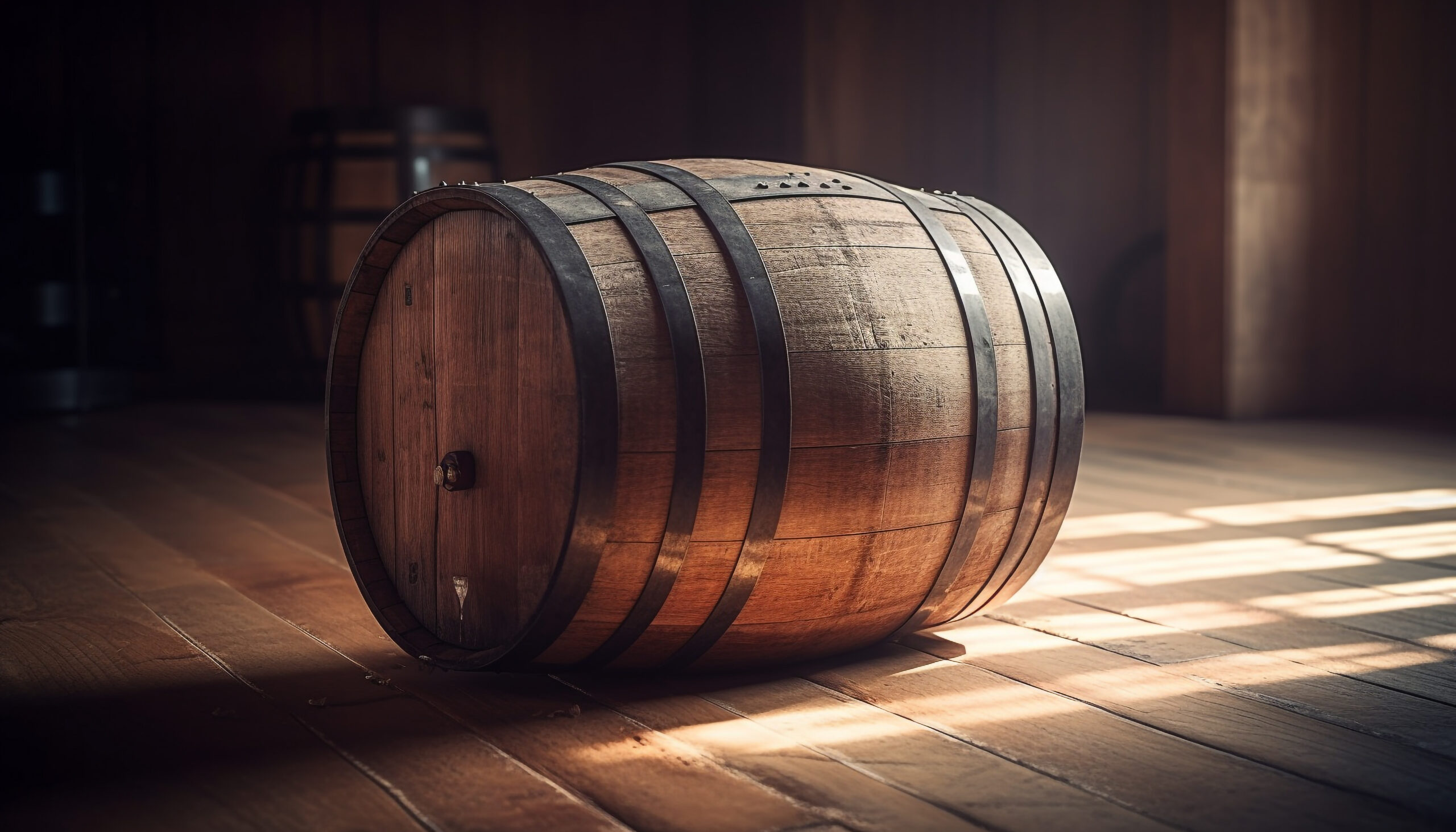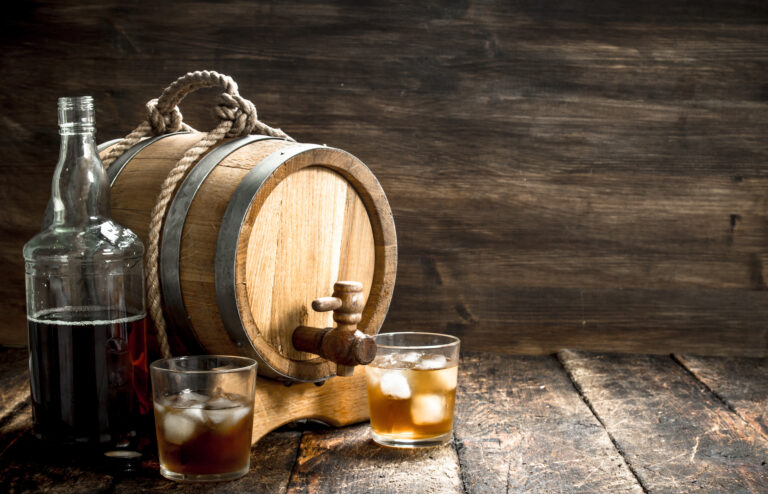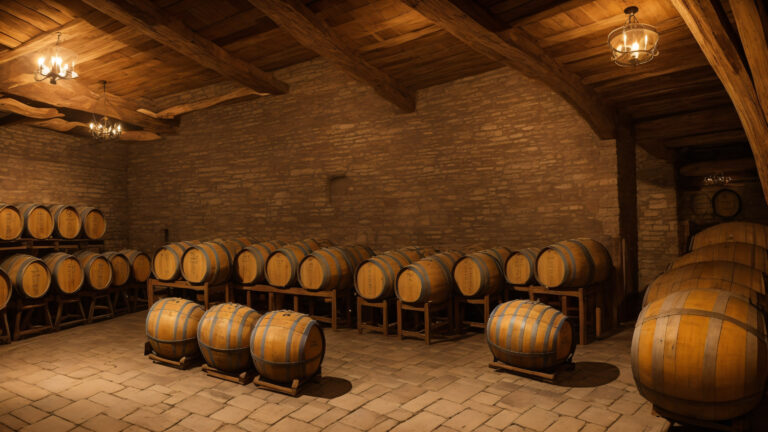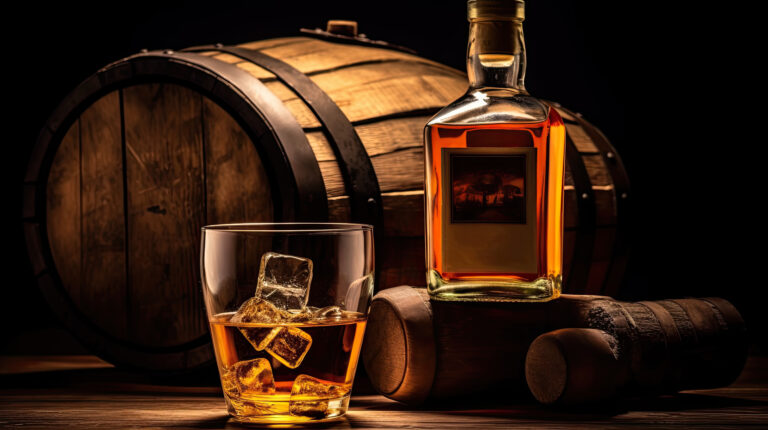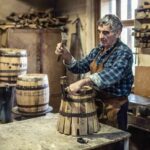Ever wondered why some of your favorite whiskeys hit you with a powerful smoky punch, while others charm with sweet and fruity notes? It’s not magic, my friend, it’s the beautiful alchemy of barrel aging. As aged spirits mature in those trusty charred oak barrels, they drink in incredible flavors and aromas from the wood. But here’s a little secret that might surprise you: barrel rotation is a true game-changer in this intricate process.
Barrel rotation is exactly what it sounds like – giving those barrels a good turn during their slumber. This seemingly simple act profoundly impacts how the whiskey dances with the wood. By rotating the whiskey barrels, distillers can meticulously control the heat and air flow within, directly influencing how the whiskey extracts those precious compounds from the oak wood. The grand finale? A truly complex whiskey brimming with unique flavors. Stick around, and let’s uncork the secrets of how barrel rotation techniques create the fine spirits you adore.
What Is Barrel Rotation and Why Does It Matter?
Think of barrel rotation as a conductor guiding a symphony of flavor extraction from the wood. As whiskey matures, it’s not just sitting there; it’s diligently soaking up compounds from the oak that bestow upon aged spirits their signature color and taste. By rotating the barrel, we’re giving the spirit a fresh encounter with new wood compounds, leading to a richer, more complex flavor profile. It’s like ensuring every note in the orchestra gets its moment to shine.
What happens during barrel rotation?
When a barrel is just chilling on its side, the whiskey only gets to mingle with the wood at the very top and bottom. But give that barrel a turn, and suddenly the spirit is seeping into different wood grains, gobbling up a whole new array of flavor compounds. We’re talking about the good stuff here: tannins, lactones, furans, and phenols – each playing a vital role in shaping the whiskey’s aroma, taste, and mouthfeel.
Rotating the barrel also allows the spirit to get cozy with the barrel head. Now, the barrel head is often crafted from a different kind of wood and harbors its own unique set of flavor compounds. Many master distillers have found that these barrel heads, often made of softer red oak, can impart delightful fruity, sweet flavors. So, by rotating the barrel to wet the head, these vibrant fruity esters can truly sing in the final spirit.
How does barrel rotation impact the final product?
Whiskeys aged with barrel rotation tend to be more sophisticated, with exquisite layered flavors of vanilla, spice, and fruit. This rotation is like a well-choreographed dance, allowing the spirit to pick up nuances from every nook and cranny of the barrel, creating a true symphony of aromas and tastes. Many distillers also observe that barrel rotation can bring forth a lovely smoky, charred note directly from the barrel char, adding another layer of complexity.
Ultimately, barrel rotation is just one brilliant arrow in the quiver of a distiller when it comes to crafting a truly full-flavored, distinctive whiskey. By maximizing that intimate interaction with the barrel wood, barrel rotation helps create a spirit that proudly showcases all the intricate flavors that wood maturation can provide.
The Chemistry Behind Maturation – The Impact of the Wood
The wood used for barrels isn’t just a container; it’s a vital, living ingredient in whiskey maturation. As the spirit patiently rests inside, it absorbs countless compounds from the oak, each one a tiny architect of its flavor, aroma, and color.
The type of wood matters immensely. In the world of whiskey, oak reigns supreme, with American white oak and French oak being the superstars. Oak boasts a remarkable structure of pores and fibers, allowing the whiskey to truly seep in. Plus, it’s packed with chemical goodies like lignin, tannins, and lactones that are flavor powerhouses.
The barrel’s char level – how much the inside has been kissed by fire – is another crucial player. A heavier char means more compounds for the whiskey to embrace, leading to a more pronounced smokier flavor. And don’t forget the toast level, or how long the barrel is heated; more toasting tends to coax out sweeter, caramelized flavors.
A barrel’s age and how often it’s been used are also key factors. An older barrel, having given more of itself, has less fresh flavor to impart, while a barrel used more often, lovingly known as a “seasoned” barrel, tends to yield a mellower spirit.
Even the warehouse environment plays a starring role. Temperature, humidity, and their daily dance of fluctuations all impact how swiftly the whiskey matures and what flavors develop. Generally, more moderate conditions tend to produce a smoother, more refined spirit.
Barrel rotation during maturation, or regularly turning the barrel, supercharges the interaction between the whiskey and the wood. This can lead to deeper colors and intensified wood flavors like vanilla, especially in younger spirits. However, sometimes less rotation allows other intriguing flavors to emerge. Some savvy distillers even employ both techniques to create exquisite layers of flavor.
In the end, it’s a beautiful synergy: wood selection, char level, barrel age, and warehouse conditions all conspire to determine a whiskey’s character and quality. By truly grasping these factors, distillers can craft spirits with utterly distinctive flavors tailored to their vision and their customers’ palates. The meticulous artistry that goes into choosing barrels and overseeing this incredible maturation process is what transforms raw distillate into the refined, flavorful whiskey we cherish.
How Rotation Affects Oxygen Exposure
The journey of whiskey maturation is a complex tapestry of chemical reactions between the spirit and that glorious oak barrel. One unsung hero in this process, significantly impacting these reactions, is the rotation of barrels during aging. As those barrels turn, the whiskey inside gets a fresh dose of oxygen, and that, my friends, profoundly influences its flavor development.
Barrel staves allow oxygen exposure
Those wooden staves, the individual planks that make up the barrel, are not entirely sealed off; they allow tiny amounts of oxygen to gently penetrate into the barrel. When barrels are first filled, the oxygen exposure is at its peak. As the barrel settles in, the wood naturally swells, which in turn reduces oxygen transmission. But here’s the clever part: rotating barrels shakes up this equilibrium, giving oxygen exposure a boost once again. This rhythmic cycle of oxidation and reduction repeats with every rotation.
Oxidation impacts flavor compounds
Increased oxygen exposure leads to oxidation, a process that helps sculpt those wonderful flavor compounds like vanillin and other oak lactones, which bring those irresistible notes of vanilla, coconut, and spice. Oxidation also lends a hand in breaking down tannins, mellowing out any potential bitterness or astringency. When oxygen becomes scarce, other reactions take the stage, forming delightful fruity esters. It’s all about finding that delicate balance between oxidation and reduction to perfect the whiskey’s flavor profile.
Char levels interact with oxygen
The level of char on the barrel also has a fascinating interplay with oxygen exposure. Lightly charred barrels, with more of their wood fibers intact, allow for greater oxygen transmission, fostering more oxidation. A heavy char, on the other hand, destroys more wood fibers, thereby reducing oxygen exposure and oxidation. The char level and porosity of the wood are key determinants of the intensity of those beloved oak and vanilla flavors.
Finding the sweet spot
For most distillers, rotating barrels just a few times during the aging process is the golden ticket to achieving that ideal equilibrium of oxidation and reduction. This masterful balance maximizes the whiskey’s flavor and aroma complexity. The precise timing and frequency of rotation depend on a constellation of factors: the barrel char level, barrel entry proof, and, of course, the specific flavor profile the distiller is aiming for. Through careful experimentation, distillers can discover that perfect “sweet spot” for their unique spirits.
Ultimately, barrel rotation hands distillers yet another powerful tool to craft whiskeys with truly distinctive and memorable flavor profiles. Understanding how oxygen exposure breathes life into maturation empowers whiskey makers to produce spirits of exceptional quality and character.
The Effect of Rotation on Temperature Changes
The barrel itself is undeniably the most crucial factor shaping a whiskey’s flavor and aroma during its maturation journey. Yet, one often-overlooked secret weapon in barrel aging is rotation. Giving those whiskey barrels a turn during their slumber exposes the spirit to subtle temperature variations within the rickhouse, and this, my friends, significantly impacts its flavor development.
Temperature Fluctuations
As barrels are rotated, the whiskey inside experiences different temperature zones within the warehouse. Think of it: the upper floors are usually warmer, while the lower floors are cooler. This temperature differential causes the whiskey to gently expand and contract, which, in turn, speeds up those vital chemical reactions between the whiskey and the wood. These reactions are the magic that imparts those wonderful oak flavors like vanilla, caramel, and spice.
More frequent barrel rotation, perhaps every 3-6 months, leads to greater temperature changes and a more rapid development of flavor. Less frequent rotation, say every 12-24 months, results in slower, more gradual transformations. Many distillers artfully tailor their barrel rotation schedules to achieve a very specific flavor profile for their aged spirits.
The Maturation Sweet Spot
The “sweet spot” for maturation is generally considered the point where wood-derived flavors are perfectly balanced, typically around 3 to 7 years for most whiskeys. Aggressive barrel rotation early on can help a whiskey quickly develop a rich oak character and reach that sweet spot sooner. Slower rotation later in maturation allows more subtle flavors to gently unfurl.
Some distilleries even go a step further, rotating barrels into specific temperature zones within the warehouse to highlight certain flavors. Higher heat tends to bring out more vanilla and caramel, while cooler temperatures can emphasize spice flavors. Barrel rotation truly gives distillers an extra lever to fine-tune their premium whiskey.
The rhythm of barrel rotation, much like a heartbeat, breathes life into a whiskey during its maturation. Those subtle temperature changes activate transformative processes that sculpt its flavor and aroma. Whether fast or slow, barrel rotation is absolutely vital to crafting a truly well-rounded whiskey. The rotation schedule a distiller employs is a direct reflection of their vision for the final product. And in the end, you can taste the beautiful results in every single dram of fine spirit.
Does Rotation Impact Absorption of Flavors?
So, does giving those whiskey barrels a good spin during maturation truly affect how much flavor they soak up? Many distillers are firm believers that rotating barrels leads to a more harmonious blending of flavors in the whiskey. As the barrel turns, the liquid inside gently sloshes over the oak wood, ensuring that every last drop of whiskey gets an even exposure to the wood. This, they argue, allows for the development of even more complex flavors.
The Science of Barrel Rotation
The theory behind rotating barrels is that it speeds up the chemical reactions between the whiskey and the oak wood. When barrels are rotated, a greater surface area of the whiskey comes into contact with the wood. This increased interaction can boost the extraction of key flavor compounds like lignin, tannins, and lactones from the wood into the spirit.
The prevailing thought is that barrel rotation, especially in the nascent stages of maturation, helps the whiskey absorb flavors from the wood more evenly and rapidly. The continuous movement of the liquid within the barrel exposes fresh areas of the wood, preventing the accumulation of “exhausted” layers right next to the wood. Distillers believe this creates a richer, more complex flavor profile in a shorter timeframe, leading to premium aged spirits.
Does Rotation Make a Difference?
Some studies have indeed suggested that barrel rotation can have a notable impact on flavor development, particularly within the initial 12 months of maturation. Whiskeys aged in rotated barrels were found to absorb certain wood compounds more quickly, develop more aroma compounds, and exhibit more pronounced color changes compared to their non-rotated counterparts.
However, not all distillers are convinced. Some argue that barrel rotation is an unnecessary step and doesn’t produce discernible differences in flavor or aroma. For them, factors like temperature, humidity, barrel char level, and other environmental conditions exert a much greater influence on maturation. They believe the added costs and labor involved in barrel rotation don’t justify the practice.
Ultimately, the debate over the impact of barrel rotation on flavor absorption continues. While some scientific evidence points to accelerated chemical changes, many distillers remain unconvinced of its absolute necessity or benefits. For those willing to invest the resources, though, barrel rotation might just be one more masterful tool in their arsenal for crafting a truly premium whiskey.
How Often Should Barrels Be Rotated?
The maturation of whiskey is an art form, demanding both care and precision. One critical factor distillers meticulously consider is the frequency of barrel rotation. This practice is essential for ensuring even maturation and preventing the formation of “hot spots” within the barrel.
As whiskey patiently rests in the barrel, it constantly interacts with the oak wood, diligently extracting those coveted flavors and aromas. The barrel staves closest to the ends of the barrel, known as the head, tend to mature the whiskey more rapidly due to their greater surface area contact. If left unturned, the whiskey in these areas could become over-matured, leading to an uneven, less harmonious flavor.
Frequent rotation, perhaps every few months or so, is a clever way to prevent this imbalance. However, too much handling can also present its own set of challenges. Every time barrels are moved, a small, precious amount of whiskey is lost to evaporation and absorption into the wood – this is often referred to as the “angel’s share.” Overly frequent barrel rotations can, therefore, reduce the overall yield of that precious aged spirit.
The industry standard for most distilleries typically involves rotating barrels 2-4 times per year. This frequency strikes a crucial balance between the need for even maturation and the desire to maximize yield. The exact schedule often depends on a confluence of factors, including the barrel type, warehouse conditions, and the unique preferences of the distiller.
Some distilleries are even getting quite experimental with their barrel rotation techniques to craft truly distinct flavor profiles. For instance, they might employ more rotations in the first year of maturation, followed by less frequent rotations in subsequent years. The thinking here is that more frequent early rotations help the spirit rapidly extract those initial, bold wood flavors, while less rotation later allows more subtle and specific flavors to gracefully develop during the longer maturation period.
Ultimately, the decision of how often to rotate barrels boils down to the pure artistry of the distiller and their vision for the final spirit. While there are general guidelines, each distillery must determine what works best given their unique materials, environment, and desired flavor profile. The possibilities for innovation and experimentation in barrel maturation are truly endless. And for us whiskey lovers, that means a whole world of exciting new flavors just waiting to be discovered in every bottle of aged whiskey.
Unique Rotation Methods Used by Distillers
Distillers are true artists, employing unique and often ingenious methods to mature their whiskey in barrels, all with the goal of enhancing flavor. As those barrels age, a fascinating ballet of complex chemical reactions unfolds between the whiskey and the oak wood. And here’s where rotation during maturation truly shines, helping to maximize that precious flavor extraction.
Barrel Rolling
Some distillers actively roll barrels to boost the contact between the whiskey and the wood. As the barrels gently roll, the liquid inside sloshes and splashes against the wood, eagerly picking up new flavor compounds. This motion also subtly aerates the whiskey, allowing more oxygen to gracefully interact with the compounds in both the wood and the spirit. Frequent rolling, especially in the early stages of maturation, often results in bolder, more wood-forward flavors in the aged spirits.
Barrel Racking
Instead of leaving barrels sideways on racks, some distillers opt for racking barrels upright on their ends. This clever technique significantly increases the wood contact, as more of the barrel’s surface area is now exposed to the whiskey. Racking is often employed later in maturation, when a less aggressive wood influence is desired. By this point, the whiskey has already extracted substantial flavor from initial rolling and sideway racking. Upright racking then adds subtle, nuanced wood notes without overpowering the spirit’s character.
Heating and Cooling
Temperature is a powerful conductor, affecting how quickly those vital chemical reactions occur within the barrels. Heating barrels speeds up the interaction between whiskey and wood, effectively accelerating maturation. Conversely, cooling has the opposite effect, slowing down these intricate interactions and the overall maturation process.
Some savvy distillers even employ a dance of heating and cooling barrels in temperature-controlled warehouses to meticulously manipulate maturation. Heating allows for the extraction of bold, robust flavors from the wood, while subsequent cooling provides a crucial window for these flavors to integrate harmoniously before further extraction occurs. The beautiful result is a perfect balance between intense wood flavors and the inherent spirit character.
Whiskey maturation truly demands an intricate dance between the spirit, wood, and environment. These unique barrel rotation methods provide distillers with even greater control over this dance, allowing them to precisely choreograph the flavor development of their aged spirits. Subtle manipulations can yield dramatically different results, all contributing to the profound art of crafting truly exceptional whiskey.
Tasting the Difference – Flavor Profiles With and Without Rotation
Once the magic of distillation is complete, the whiskey begins its transformative journey, lovingly aged in charred oak barrels to imbue it with its glorious flavor and color. And let me tell you, barrel rotation during maturation has a profound impact on the ultimate flavor profile of that delicious whiskey.
As the whiskey ages within the barrel, it patiently absorbs vital compounds from the oak wood – think vanillin and tannins – which bestow those delightful notes of vanilla, caramel, and spice. The charred inner layer of the barrel also contributes wonderfully smoky flavors. Over time, the concentration of these wood-derived flavors intensifies. However, these flavor compounds aren’t always evenly distributed throughout the barrel if left static.
The barrel staves (those wooden planks) at the top and bottom of the barrel boast more surface area exposure, leading to a greater interaction with the whiskey. The whiskey in these areas will likely exhibit more prominent oak, vanilla, and caramel notes.
Meanwhile, the barrel headspace – that crucial space above the liquid line – is exposed to more oxygen, leading to oxidation and evaporation. This often results in nuttier, drier flavors.
The very center of the barrel tends to hold the least amount of wood-derived and oxidized flavors, with more of the original grain-forward notes still wonderfully intact.
By thoughtfully rotating the barrel, the distiller ensures that all areas of the whiskey are exposed to the full spectrum of flavors at some point during maturation. This masterful touch results in a more complex, well-rounded flavor profile in the final product. These subtle yet significant differences achieved through rotation are often what truly sets craft whiskeys apart from their mass-produced counterparts.
When you have the opportunity to taste whiskeys from statically aged barrels versus those from rotated barrels, the differences truly become apparent. The static barrel often produces a whiskey with uneven, perhaps unbalanced wood and grain flavors, sometimes lacking in overall complexity. A rotated barrel, on the other hand, yields a harmonious blend of oak, caramel, nuts, and grain that lingers delightfully on your palate. For the true whiskey connoisseur, the choice is clear – barrel rotation is a key ingredient in achieving whiskey perfection and a truly premium spirit.
The Impact of Barrel Rotation on Whiskey Maturation – FAQs
Barrel rotation during the maturation process is a subtle yet powerful force that significantly impacts the flavor compounds that develop in whiskey. As the barrel gently turns, the intricate dance between the whiskey and the oak wood changes, beautifully influencing the ultimate flavor profile of the aged spirit.
Evaporation
Rotation increases the surface area exposure of the whiskey to the air, which in turn speeds up oxidation and evaporation. This phenomenon, famously known as the “angel’s share,” results in a small loss of volume, but crucially, it also leads to a concentration of flavors. As the whiskey evaporates, it absorbs even more of those desirable oak compounds.
Oak extraction
Whiskey extracts different compounds from the oak barrel at varying depths within the wood. Rotation ensures the whiskey gets to mingle with more of the barrel, incorporating flavors from the middle and bottom in addition to the top and sides. This comprehensive interaction often leads to more complex, multi-dimensional notes in the final spirit, showcasing the true depth of the wood maturation process.
Temperature changes
The temperature inside the barrel subtly fluctuates during rotation due to convection currents. These gentle temperature changes cause the oak wood to expand and contract, which in turn boosts the infusion of oak compounds into the whiskey. The dynamic interaction between spirit and wood is highly dependent on temperature.
Sediment redistribution
As whiskey matures, a natural sediment can form at the bottom of the barrel. Rotation cleverly redistributes this sediment, allowing more of its flavor to be incorporated into the spirit. This sediment contains valuable oak tannins, lignins, and other compounds meticulously extracted from the wood.
Oxygen exposure
Tiny amounts of oxygen gracefully enter the barrel during rotation, leading to a gentle oxidation of the whiskey. This controlled oxidation helps create desirable flavor compounds like acetals. It also plays a role in polymerizing tannins into larger molecules, which effectively smooths out any harsher oak notes. Achieving controlled oxidation is truly key to good maturation.
Ultimately, barrel rotation fosters a more active and dynamic interaction between the whiskey and the oak, positively influencing the entire flavor development journey. By skillfully manipulating rotation, distillers can craft a truly bespoke spirit with their desired flavor profile. The continuous dance between spirit, wood, and oxidation is both a fascinating art and a precise science in the world of aged spirits.
Final Thoughts
So, the next time you savor a delicious glass of aged whiskey, take a moment, close your eyes, and truly appreciate the subtle, incredible flavors lovingly imparted by that humble barrel. The barrel isn’t just a container holding the whiskey during maturation – it’s an active, vibrant participant, meticulously shaping the flavor through a complex, beautiful interaction of wood and spirit. By diligently rotating barrels during maturation, distillers are able to craft truly unique, complex flavors in their whiskeys. The graceful movement of the liquid, in and out of the oak wood with each rotation, allows for an ideal exchange of flavors between the wood and the spirit. While barrel rotation certainly demands more effort and expense, the results speak for themselves in each rich, distinctive sip of premium whiskey. The humble barrel might seem like a simple vessel, but within its wooden staves lie the profound keys to crafting a truly memorable and exceptional whiskey.
